
Major current projects that are currently underway to have humans on Mars for exploration and also for possible settlement and colonization are the Mars One project and NASA project. There are still several geotechnical engineering tasks that have to be considered for the realization of the planned forthcoming human missions on Mars.
Geotechnical difficulties linked with soils on Earth situated above the groundwater table (i.e. vadose zone) with negative pore-water pressure range (i.e. suction) are naturally determined by the mechanics of unsaturated soils.
The majority of the soil on the exterior of Mars is made of fine particle size (range of < 0.002 mm- 0.075 mm that usually have clay and silts). These soil sizes are considerably predisposed by the effect of low gravity (one-third of Earth’s gravity) on Mars’ soil mass. Microgravity can create problems in the transference mechanism of liquid water, gases, and heat inside the soil on Mars. The soil suction is a crucial issue that influences the strength of the unsaturated soil slopes.
The mechanical characteristics such as the shear strength, stiffness, and bearing capacity are comparatively high and propose resistance to distortion in unsaturated soils due to the contribution of suction. However, some unsaturated soils collapse (i.e. collapsible soils) or swell (i.e. expansive soils) due to saturation because of suction disappearance. The soil suction potential significantly rises during a temperature decline lower than the freezing point of water.
The mechanics of unsaturated soils, a developing field of study, has delivered explanations for tackling numerous geotechnical problems. The existing understanding of unsaturated soils seems an important tool on Mars to simplify forthcoming human exploration and colonization.
Mars Soil Conditions
Facts about atmosphere, surface and underground conditions of Mars can be found in other sources. Martian soil generally contains a great concentration of Fe, S, and Cl components; its red color is ascribed to iron-oxides created from weathering of rocks in wet and humid periods of Mars. Some physical and engineering characteristics of Martian soils are shortened in Table 1.
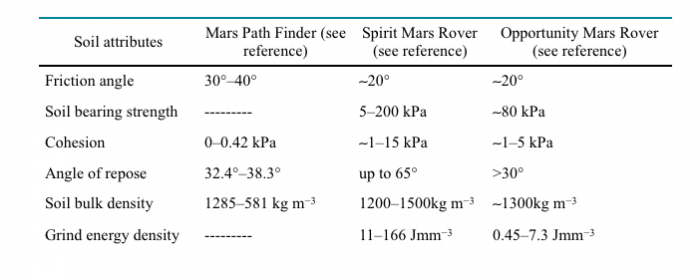
Table 1: Martian soil physical and engineering characteristics at three rover examination locations
Duricrust: a cemented and collapsible soil, i.e., unsaturated soil on Mars
Cemented and collapsible soils, which are recognized as duricrust or false pebbles, occur on 25% of the surface of Mars (Figure 1). Their structure contains particles cemented by connecting materials, which has been concluded from albedo and thermal inertia factors. These soils were detected at the Viking and Pathfinder landing sites. We do not know too much about the depth of this soil stratum from all portions of Mars, and this is true about Earth as well. The presence of unsaturated soils on Mars assembled in false pebble form is visible in Figure 1a. The disruption of unsaturated cemented soils (duricrust) configuration by Mars rover is observed in Figure 1b. Presence of unsaturated soils on Mars surface can be also concluded from Figure 1c-d.
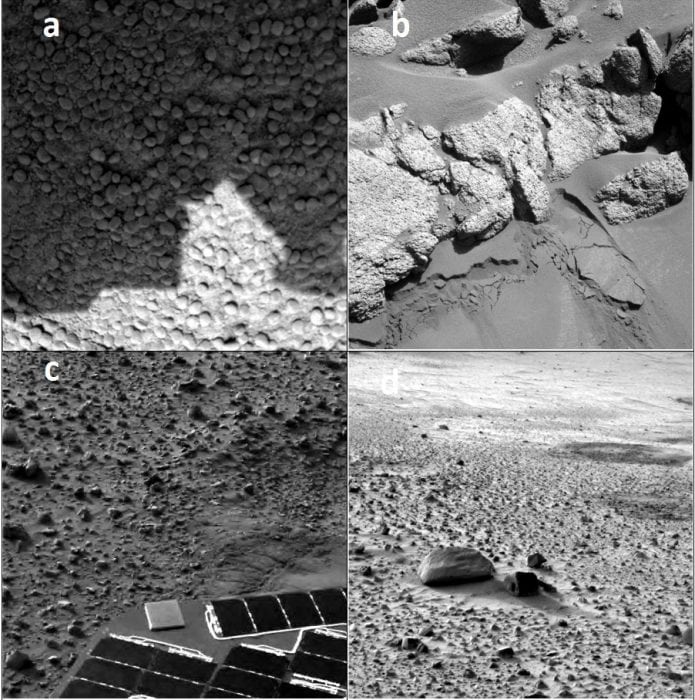
Figure 1: Manifestation of a cemented and collapsible soils on Mars in unsaturated conditions acquired from NASA images. a) False pebbles on Mars spotted by Spirit Mars rover at Gusev Crater. b) Unsaturated soil (Duricrust) on the slope near Gusev Crater disrupted by Spirit Mars rover movement. c & d) Spread of unsaturated soils on the Mars surface as depicted by panoramic camera of Spirit Mars rover at Gusev Crater.
The occurrence of a vadose district or unsaturated region at the subsurface of Mars can be concluded from sedimentary assemblages such as fans, deltas, and cross-bedded layers. The suction and falling of surface strain during soil particle contact activates a precipitation of minerals. A deposition of new crystals takes place in a transitory way to the unsaturated stage among soil particles from pore water with high concentration of chemicals.
The crucial geotechnical hazard associated with unsaturated soils can occur from the collapsing nature of duricrust on Mars. The surface of Mars is spotted with false pebbles, which are mildly cemented, fine-grained soils in a range of silt sizes. They were crushed when the Viking sampler arm was gathering them. The collapsible soil in dry standing has significant stiffness but breaks down quickly when drenched with water. The light cementation by salts or clay shells is softened by water penetration, and the soil collapses to a denser arrangement.
Some engineering difficulties are expected if foundations are built on the unsaturated collapsible soils. These soils can unexpectedly breakdown because of overloading, a sinusoidal dynamic load, or moistening caused by molten ice. Some solutions can be used to prevent the risks linked with the collapsible unsaturated soils in upcoming human colonization. Foremost, this variety of soil can be displaced from locations where their thickness is low. Next, the soil can be compressed to a greater compactness and density to attain satisfactory settings.
These resolutions are proposed considering the following expectations: two forms of structures that consist of either surface or underground shelters can be constructed on Mars to shield humans from severe weather circumstances or serious solar and galactic radiation influence. For any edifice constructed on Mars ground or underground surface inside thick deposits, geotechnical characteristics of the soil should fulfill the lowermost necessities considering stability and deformation (i.e. collapse).
Unsaturated phase seen from desiccated polygons
Plentiful geometric cracks (Figure 2 and 3) can be detected on the exterior of Mars from pictures sent by lander and orbiting space crafts. These polygons on Mars show dissimilar sizes extending from 2 to 3 m up to 10 km in diameter. Thermal shrinkage, dehydration, or volcanic developments are the key reasons for the creation of small-size polygons (2 to 20 m) and intermediary size (20–300 m), and tectonic events are responsible for the bigger, kilometer-sized, polygons.
The desiccation theory suggests that endogenic ponds, or the inundated sediments shaped in the impact craters, created polygon form soil assembly. It was recommended that those lakes probably hold water, drenched by the hydrothermal developments or by the influence of triggered groundwater seepage just after the meteorite impact occurrence. Desiccation is an aeration stage coupled with dehydration of water from the surface or as a result of diffusion developments that happen in a soil which initially was in a drenched state.
These observable developments propose the movement of the liquid water caused by water potential variance. Such a development can be ascribed to vapor movement due to a discrepancy in the water vapor pressure. If the soil is disallowed from the shrinkage as a result of the loss of volatiles, stress mounts up and extends to a value that is more than the strength of the soil. Consequently, cracks are formed to relieve the additional stress. The occurrence accompanying the desiccation cracks in clay soils on Earth is analogous according to the studies by different researchers.
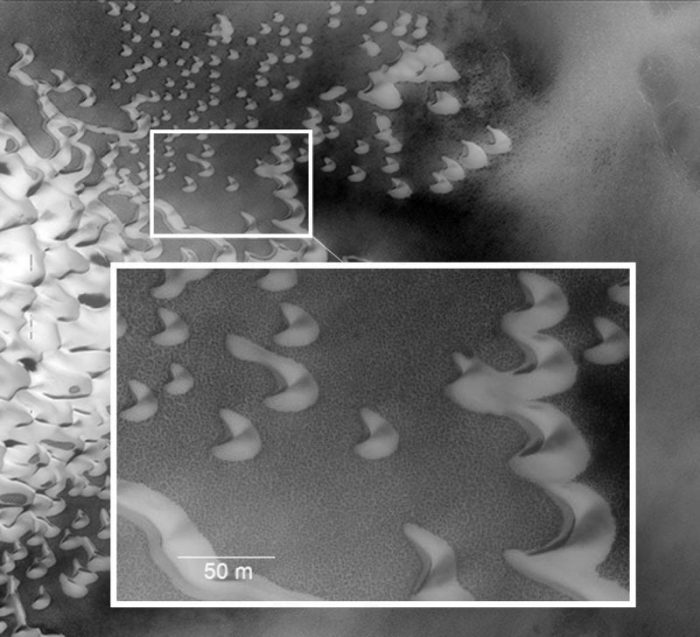
Figure 2: Desiccated geometric shapes, observable close to Martian dunes, illustrated by high-resolution HiRISE camera mounted on the Mars Reconnaissance Orbiter (Image from NASA).
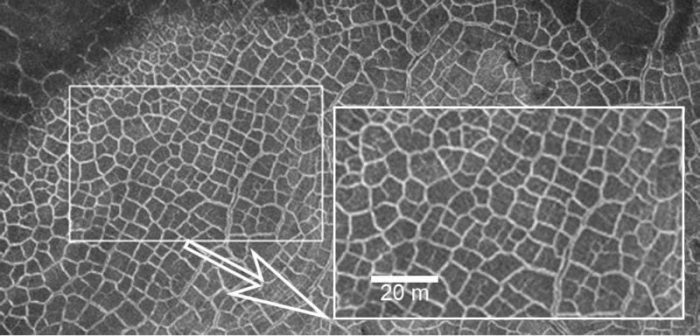
Figure 3: Desiccated polygons occupied with ice, illustrated by high-resolution HiRISE camera (Image from NASA).
Martian landslides and the effect of unsaturated soils
Debris movements and gully features can be perceived frequently on the Martian surface. Cutting interface with additional surficial structures on Mars and the treatment by the young-age dunes shows that these gullies are relatively young structures. Furthermore, the gullies ha ave sharp appearance compared to the older topographies that were prejudiced by landslides or aeolian developments. The presence of gullies occurs beside some latitudes with extra exposure to the Sun.
Research was executed on a range of contact to solar energy in the Martian hillslopes in the northern hemisphere, composed of gullies and no gullies. It was perceived that hills with gullies have a reasonably fixed quantity of contact to the Sun throughout the year. This exposure was as a result of their slope geometries, and predominantly because of their latitudes and aspects (facing bearing). Gullies creation shows that there are unsaturated soils in these districts that tolerate drenching occurrences. The wetting of unsaturated soils can be ascribed to ice melt and capillary movement of water. The water drenches superficial soils, decreases suction and drops the shear strength, resulting in their downhill movement (i.e. collapse).
Subsequently, debris flows, gullies, and fan-shaped landscapes are produced on the surface of Mars (Figure 4-Left). Landslides can have diverse activating mechanisms, and argument on this topic is not delivered here because of the paper’s space restrictions. Landslides in a minor or huge scale (Figure 4) in the preceding or current time of Mars can be as a result of a wetting pathway or are attributable to a wetness phase in the unsaturated soils, besides the impact of gravity and dynamic loads. Vibrant loads can initiate from triggered seismic properties of meteorite impacts (Figure 4-Right) or Marsquakes. The occurrence of collapsible soils in unsaturated phase with the probability of sheer strength forfeiture as a result of dynamic loading is a key reason for landslide happening on Mars. Also, debris flow caused by moistening or saturation of the unsaturated soils is the chief prevailing landslide mechanism on the exterior of Mars.
A study displayed that liquid movement in the superficial subsurface, the slope incline, and steadiness of regolith mantle on hills, can control debris flows on Mars. Founded on the earlier study and current result from SHARAD (Shallow Radar Mars Reconnaissance Orbiter), it can be inferred that a liquid material will moisten the ground in Martian unsaturated soils. This liquid is potential groundwater derived from both the water-ice in the Martian subsurface, the thaw of massively dispersed superficial subsurface ice, or from subsurface hydrothermal movement.
Henceforth, places of human settlement on Mars near raised zones, inactive volcanoes, or slopes should be avoided. This is because gravity influence, dynamic loads, and moistening of the unsaturated soils through ice melt can cause landslides, containing fast-moving debris flows. Water occurs in combination with ice, or merely in ice form, below the Martian surface. Contact with solar energy, underground hydrothermal movement, and dispersion of water vapor to outward or meteorite waves shocks can deliver heat sources for melting ice. This heat can thaw the undersurface ice and produce liquid water. Water can penetrate inside the soil or escalate by capillary movement, dropping suction of unsaturated soils, causing shear strength reduction and escalation in deformation (i.e. collapse), consequently.
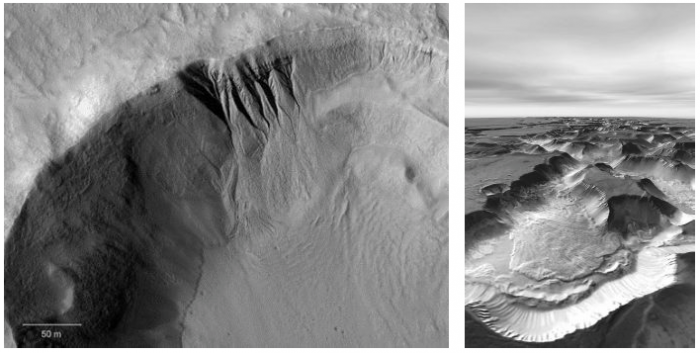
Figure 4: Left) Debris flow and gullies in a southern hemisphere crater on Mars illustrated by HiRISE camera, and their creation by thermal and the unsaturated soils impact (Image from NASA). Right) a landslide on Mars surface activated by a meteorite impact and collapsing nature of unsaturated soils due to the dynamic load. (Image from the thermal emission imaging system, THEMIS, in the vast Noctis Labyrinthus system, located west of the giant rift valley of Vallis Marineris)(Image from NASA).
Unsaturated status found in Martian frozen soils
Frozen soils exist on a vast surface of Mars. The temperature on Mars can differ from -153 to +20 degrees Celsius in diverse places and periods of the year. Warmness from daylight, subversive hydrothermal gradients, and meteorite impact shock can alter ecological circumstances and dissolve frozen soils. The soil mechanical properties — specifically, rigidity and shear strength — are important factors necessary for the design of foundations.
Frozen soils display a greater primary tangent modulus (i.e. stiffness) as a consequence of resistance created inside the soil by ice that increases by rising in confining pressure. In the silts, which are generally fine-grained cohesionless soils, the soil suction increases the apparent cohesion and consecutively escalates the shear strength. Profoundly, the soil suction rises in the frozen soils, and it can be inferred that moisture ratio influences the shear strength of the soil by the involvement of suction. Difficulties happen when the saturation degree of the soil rises as a result of dissolving ice. Owing to this reason, there is a decrease in soil suction, shearing strength, stiffness and bearing capacity of the melted soil. Exposure to the sunlight or hydrothermal systems can provide the heat source.
Recommendation for further research
Complementary research is suggested on the interactions of water, water-ice, dry ice, and soil allowing for the impact of soil suction on the hydraulic and engineering characteristics of the unsaturated soils. Additional recommendations include testing in space stations with reverence to the effect of microgravity by means of dissimilar types of Martian simulant soils assorted with water or dry ice. These experiments will permit us to increase our knowledge about the impact of soil suction on the engineering properties that can be suitable for civil and mechanical infrastructure schemes on Mars. Finally, study and analyses on the unsaturated Martian soils should be extended to better comprehend problems and to suggest effective solutions. This research can enhance the successful human colonization of Mars in the near future.
These findings are described in the article entitled Unsaturated soils on Mars and their impact on human missions and settlement on Mars, recently published in the Electronic Journal of Geotechnical Engineering. This work was conducted by Morteza Sheshpari and Sai K. Vanapalli from the University of Ottawa.









